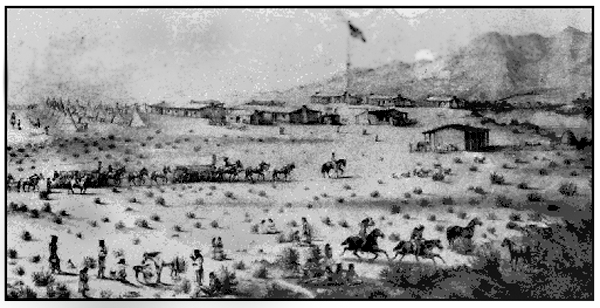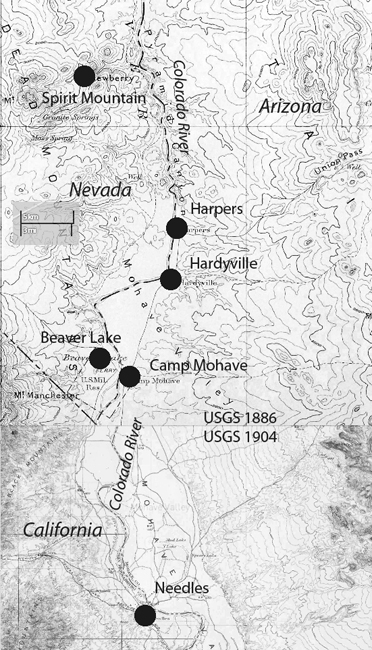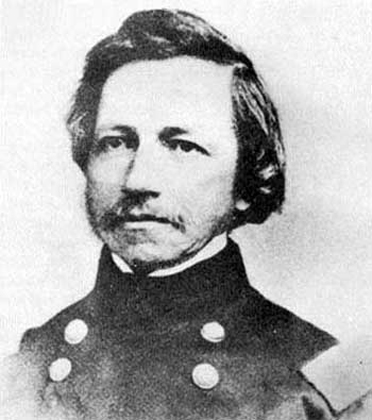Fort Mojave History
During the early part of the 1850s, the United States government was sending out parties to study certain suggested routes for a transcontinental railroad. One such route under consideration followed approximately along the 35th parallel from Arkansas west and had been surveyed by Lieut. A. W. Whipple in 1854. it ran into the San Bernardino-Salt Lake Rd. at the Mojave River a few miles east of what is now the desert town of Daggett, thence to San Bernardino and Los Angeles via the Cajon Pass.
Shortly after Whipple's survey, a concerted effort was made to open a wagon road along this line.
"In 1857, Congress appropriated money for such a road from Fort Defiance, in the Navajo country in northeastern Arizona, to the Colorado River. Edward Beale, a former Navy Lieut., was employed by the Secretary of War to had the undertaking. The point where his road reached the Colorado was the point where, later, Fort Mojave was established, and the crossing there was long known as Beale's crossing."
When Beale was starting on his undertaking to open the 35th parallel road across northern Arizona to the Colorado. He was ordered to make use of camels, and deliver them at Fort Tejon. He was entirely willing to try them and gave them a thorough test. His conclusion was summed up in his report when he dubbed them, despite numerous difficulties encountered during the testing, "the noblest brutes on earth."
"The Beale road ran through the Mojave Indian country, and the Mojaves resented the coming of white men to their lands. Their attacks on emigrants and mail carriers grew so serious that the government decided to place a military force on the Colorado River for the protection of travelers."
Lt. Col. William Hoffman was sent by Washington to select a site for the Fort. Hoffman was unimpressed by the area but the Army officials were convinced that the post should be on the Colorado River in Mojave Indian territory. Thus it was that Fort Mojave was established in 1858. From this site the troops, under Major Amistead, were able to control the depredations and defeat the hostels on their own grounds whereupon they sued for peace. The Army saw fit to keep the camp active to ensure peace within the area until May 1861 when it was abandoned.
During the first active period of the Fort it was a major undertaking to supply the garrison with the necessities of life. the Colorado River steamboats proved uncertain since navigation was difficult and at times impossible. It was during such a dire situation that a rather and enterprising young Captain decided to take a calculated risk to relieve the Fort. Capt. Winfield Scott Hancock sent a relief force of Banning's best desert teamsters to conduct 10, eight mule-team wagons with supplies over the desert route. The relief force reached the river boast in 16 days and reportedly found the road excellent, for a desert road. Hancock described the area is having sufficient wood, water, and grass along the way.
Capt. Hancock's bold decision to ship supplies overland proved successful in several respects. Not only did he get the supplies to the Fort in a quicker period of time, but he also was able to reduce the cost of shipping by a substantial amount. Prior to his experiment, supplies were transhipped from San Francisco to the camp via the Colorado River. The new route from Los Angeles across the desert was much shorter and more certain. (San Bernardino freighters used this road along the Whipple survey later, not only in furnishing Fort Mojave was supplies, but also in hauling to the mining camps which later developed.)
From 1858 to 1861, four Mojave acted as the eastern anchor to a line of forts and redoubts established along the major trails of the Mojave. In 1861, Fort Mojave was abandoned on the order of Gen. Sumner when he took over command of military affairs in California at the outbreak of the Civil War. Gen. Sumner felt he could use his troops along the river to better advantage elsewhere.
The need for troops arose again, however, when miners discovered gold on the eastern side of the Colorado near the fort. The fort was reestablished in 1863 for the protection of these miners. Another factor was the closing of the southern routes into California by Confederate forces from Texas. Thus, it became desirable to have a mail route further north, and this renewed interest in the Beale wagon road, hence the need for the reoccupation of the camp.
Adapted from : San Bernardino County Association - Winter 1970
by Leonard B. Waitman
Description of Camp Mojave
Life at Camp Mojave



.jpg)